Vr Mapping |
ON-LINE REFERENCE DOCUMENTATION CARDINAL SYSTEMS, LLC |
Point Draping (VrOne/VrTwo)
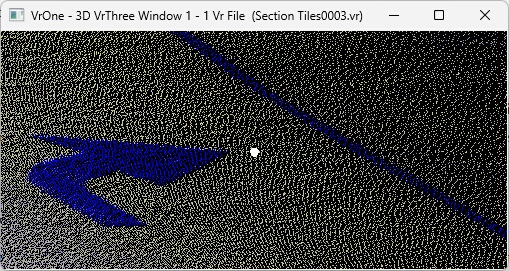
Overview
Point Draping allows the cursor (measuring point) to be draped onto VrPoints, which are typically LiDAR or Digital Surface Model (DSM) points. This feature is available in VrOne and VrTwo, while VrThree (VrLiDAR) has its own version called Cursor Draping. Point Draping operates in real-time, recalculating the cursor's elevation with each movement in the x and y directions. It is a global mode, meaning it is always available in VrOne and VrTwo.
Modes
There are two possible modes for Point Draping
| • | Single Drape - The cursor is draped one time with the "Z HL" (High/Low) key-in or the "Z TRI" (Triangle) key-in. |
| • | Continuous Drape - The cursor is continuously draped as it is moved in the x, y direction. Data collected with any of the interactive applications uses the draped elevation. |
Methods
The High/Load Point Buffer
There are two possible methods of draping the cursor. Both methods use the High/Low point buffer. This buffer stores VrPoints within a user defined radius of the cursor location. A buffer Z tolerance is used to define the minimum and maximum Z of the buffer. The result of these three parameters is a cylinder of 3D VrPoints which can be used, real-time, by the draping applications.
The Point Drape Application (PoiDraApp) is available to show and edit the Point Drape parameters.
High/Low Method
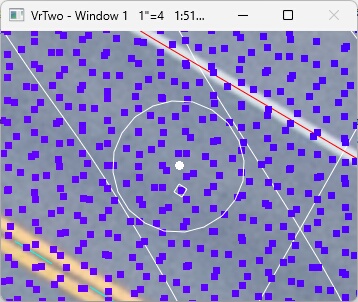
High/Low Point Drape Method
This method uses a High/Low searching method to determine the elevation of the cursor. Please see High/Low Point Search for more information about this existing search method. High/Low point searching is an option in several Vr Mapping applications such as Insert Line (InsLin) and Insert Symbol (InsSym). The High/Low point search is useful if the source LiDAR data contains vegetation. By setting the search for the lowest point in the buffer, the chances of obtaining the ground elevation is increased. The High/Low point is chosen based on the user parameters and is recomputed each time the cursor is moved in the x,y direction..
Triangle Method
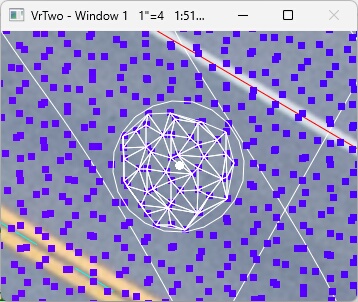
Triangle Point Drape Method
A surface model is created using the points in the buffer and break lines to create 3D triangles. This is the same method used with the Run Dtm command. The formation of the triangles occurs real-time each time the cursor is moved in the x,y direction. The elevation is computed at the cursor location based on the triangle that it falls within. The search radius for this method may be small because only a few points are needed to form a 3D triangle around the cursor location. The buffer may contain up to 10,000 point per cursor movement. If the number of points in the buffer exceeds 10,000 then no triangles will be displayed. The cursor elevation is adjusted each time the cursor is moved in the x,y direction.
In the example above, 3D triangles are formed from the points inside the High/Low buffer along with break lines whose layers are defined in Z Source dialog (ZSou). The triangles on the edge of the radius circle are nor fully formed but the triangles in the center are. The elevation is taken from the triangle at the cursor location.
Configuration
Point draping is a user defined mode in Z Source (ZSou) and the parameters may be set using a dialog with the ZSou key-in with no parameters.
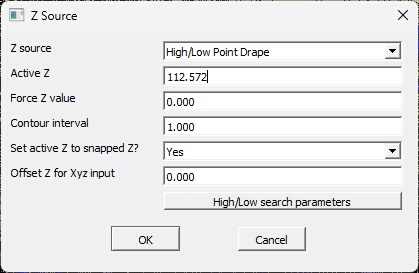
Z Source set to High/Low Point Drape
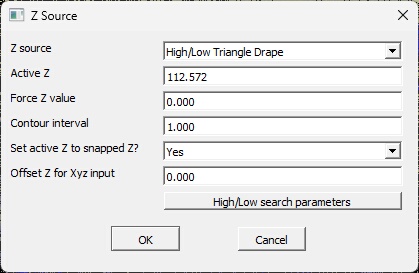
Z Source set to Triangle Drape
Triangle Drape breakline layer (NumLine) - If the Z Source is set to High/Low Triangle Drape, break lines may be added to the triangulation by defining the layers containing the break lines. These layers are defined by a Number Line
A key-in may be used to change the Z Source without the dialog as shown below. This allows the Z Source to be changed from anywhere key-ins are supported. This would include Macros, Function Keys, 3D mouse button assignments, and general key-ins.
Key-in |
Definition |
ZSou ACTZ |
Xyz input device or the Active Z |
ZSou DTM |
Drape to the previously computed DTM surface |
ZSou FORZ |
Use the Force Z which is a user defined constant |
ZSou HL |
Use High/Low point search |
ZSou TRI |
Create 3D triangles from the points in the buffer |
Point Draping added May 2024 - Version 07.01.23
Jan 2025 - Added support for break lines - Version 07.01.24